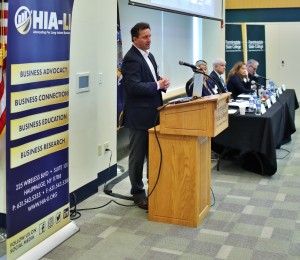
The much-anticipated report, “Innovating the Talent Pipeline: Strategies for Workforce Development in the Long Island Innovation Park at Hauppauge,” was unveiled at HIA-LI’s “Workforce Development Conference and Scholarship Awards” event on October 13, 2023, at Farmingdale State College. This report is a testament to our commitment, as outlined in my June 5, 2023 blog post, to address the skills gap on Long Island.
The Long Island Innovation Park at Hauppauge (LI-IPH), the Northeast’s largest industrial park, is a beacon of regional economic strength, with over 1,300 companies and employing more than 55,000 workers. However, the challenge of a skilled workforce shortage looms large. This report, a collaborative effort between HIA-LI, the Suffolk County Industrial Development Agency (IDA), and the Workforce Development Institute (WDI), provides a roadmap to ensure the long-term resilience and competitiveness of the Long Island business sector.
James Lima Planning + Development, a renowned a New York City-based planning, real estate, and economic advisory firm, undertook the strategic analysis. Their comprehensive study, based on surveys from 34 Long Island employers, sheds light on the skills and talent needs of businesses, with a special focus on the LI-IPH.
The report’s findings are both insightful and actionable. It emphasizes the importance of:
- Access and Awareness: An island-wide campaign to promote resources such as adult English classes, career support, and job fairs.
- Strengthening Industry-Academia Partnerships: Encouraging project-based learning, AI tools, and best practices in the manufacturing sector.
- Promoting Intra- and Cross-Sector Collaborations: Highlighting best practices, foreign language support, and software training.
- Fostering a Learning and Advancement Culture: Championing mentorship initiatives and branded learning programs.
- Building Affordable and Attractive Communities: Advocating for workforce housing and transit-oriented development.
I’d like to extend my gratitude to the panelists and contributors who made this event and report possible. Their insights and expertise have been invaluable.
- Dr. Ed Bonahue, President, Suffolk County Community College, and an HIA-LI Board Member
- Rich Humann, President & CEO, H2M architects + engineers, and an HIA-LI Board Member
- Robert Kufner, President & CEO, Designatronics, Inc.
- James Lima, President, James Lima Planning + Development
- Liz Uzzo, Senior Vice President, Human Resources, H2M architects + engineers
- Dr. Bahar Zoghi, Assistant Dean, Farmingdale State College
And of course, a special thanks to our partners in this effort: Kelly Murphy, Acting Executive Director of the Suffolk County IDA, and Robyn Fellrath, Long Island Regional Director at the Workforce Development Institute. We couldn’t have done this without their steadfast support.
Another highlight of the morning was the Scholarship Awards ceremony. This initiative is more than just financial assistance; it’s a commitment to the future of Long Island. By providing scholarships to high school graduates who choose to pursue their college studies here on Long Island, we’re not only investing in their education but also fostering a sense of community and continuity. It’s a clear message: we believe in the potential of our young minds and the promise they hold for our region’s future.
It’s also a testament to our dedication to keeping local talent local. By incentivizing our youth to study and subsequently work in the Nassau-Suffolk region, we’re ensuring a steady stream of skilled professionals who are familiar with the unique challenges and opportunities here on Long Island. These young individuals, equipped with local knowledge and a world-class education, will be the driving force behind Long Island’s continued economic growth and innovation.
In conclusion, as the President and CEO of HIA-LI, I am proud of this monumental step towards bridging the skills gap on Long Island. The recommendations in this report are not just words on paper; they are a call to action. Together, we can ensure a vibrant, resilient, and future-ready regional economy.
